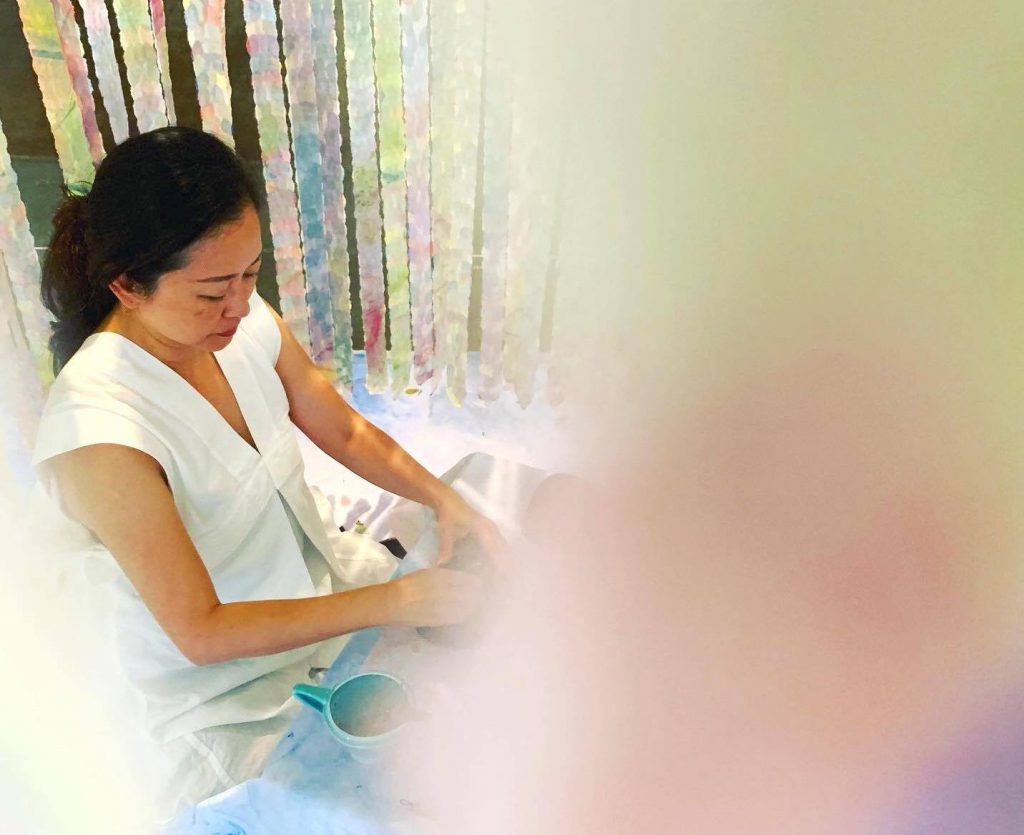This past September, artist Ines Sun was teaching Chinese calligraphy in a large outdoor tent in Virginia’s Shenandoah National Park. As one of the park’s 2023 Artists in Residence, the Brooklyn-based multidisciplinary artist demonstrated nature-based characters and traditional posture, breathing, and brushwork with a deft hand and grounded presence, seemingly undisturbed by the strong winds that would periodically lift participants’ paper from their tables. With an enthusiastic and nonjudgmental instructional style, Sun’s teaching was less about commanding her pupils and more about the power of suggestion, as if pointing out a beautiful vista that they might care to enjoy. In a welcoming atmosphere of artistic grace and play, students of all ages dropped into the moment to experiment with their designs. This public engagement is crucial to Sun’s overall practice and conveys her bodhisattva-like approach to making art. “I see my art, including painting and installations, as a service to all,” she says.
The stroke of a calligraphy brush flows long and deep throughout Sun’s life. As a child growing up in Taiwan, her grandfather taught her the foundations of calligraphy, a skill that was also transmitted to her father. She recalls growing up surrounded by Chinese brush paintings of flowers and birds, and how her grandfather wrote short poems in ink to express “frustration with the Communists.” (Her parents were born in China, but her grandparents felt the need to move their families to Taiwan “because of the Communist takeover.”)
While a multidisciplinary artist, Sun’s interest in calligraphy can be seen all throughout her life’s body of work, including her practice of calligraphy as a “purification” ritual done before engaging in oil painting sessions, her workshops teaching Chinese calligraphy through regular copying of the Heart Sutra, along with her most experiential offering: the Mobile TeaHouse.
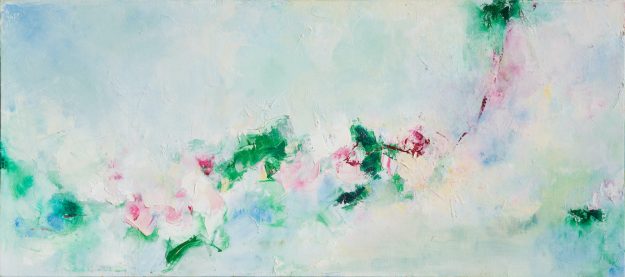
An Ephemeral Oasis
The Mobile TeaHouse installation is a one-on-one encounter with Sun that combines ink tutorials with a tea ceremony inside a temporary space, typically shaped by silk walls, sashes, and curtains, often incorporating Sun’s paintings, which can feature lush depictions of nature. Beginning with the Brooklyn Art Fair in 2011, Sun has now created the Mobile TeaHouse (sometimes referred to as a tea garden or hut) installation seven times, including at Taiwan’s Lanyang Museum and Suho Memorial Paper Museum, and at the Tenri Gallery in New York City’s Greenwich Village.
“I transform and quiet myself down through drinking tea and calligraphy,” Sun says. “[And so] I realized, I can simplify this and share it with other people so they can find peace within themselves.”
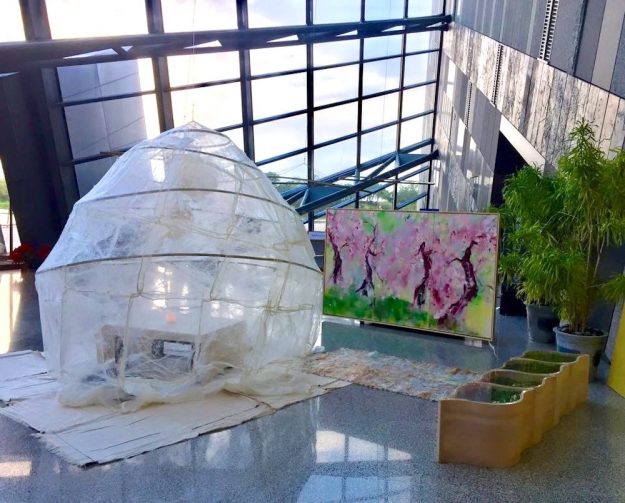
Throughout the teahouse’s various incarnations, Sun has experimented with format and ambiance, collaborating with different artists working in sound, stone, as well as textiles, including silk art master Akihiko Izukura. As part of this installation series, Sun created the Heaven and Earth TeaHouse (“天地茶屋” or “TianDiChaWu”), in which a participant spends fifteen minutes in silence with the artist engaging in a silent meditative ritual, inspired, at least in part, by her knowledge of Japanese tea ceremonies. “I got rid of the Japanese part,” she says, “but I used that rhythm; I kept the discipline and the movement.” Sun explains her project further:
“People gradually focus on my movement because there’s rhythm to it…I make them tea and we drink. [Then we start] grinding ink, [which is done in] a circular movement that usually quiets people down immediately. When they start to write, even if they don’t know Chinese, there’s something about touching the brush to the paper—it helps you connect with your being, and you have to pay attention. It’s body and mind.”
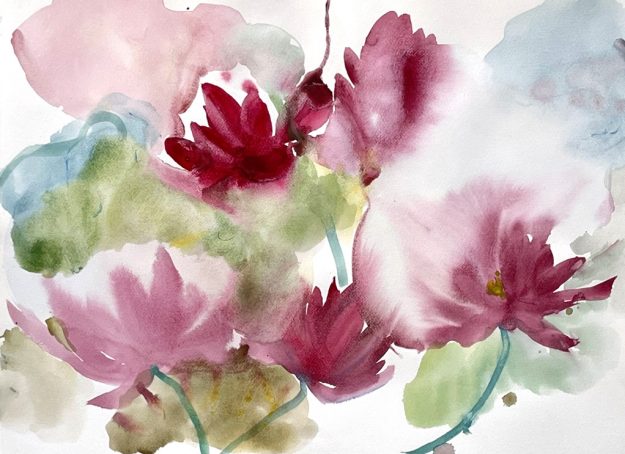
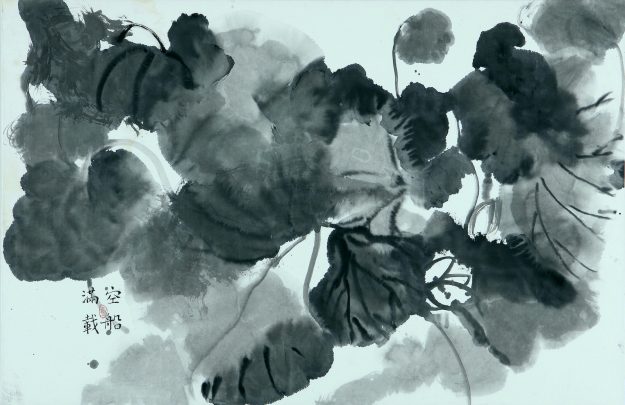
A Unique Combination
The Mobile TeaHouse is a synthesis of Ines Sun’s specific life experiences: her familial tradition of Chinese calligraphy, her study of contemporary painting, and her years spent running a for-profit tea room in New York.
In 1995, Sun studied oil painting and Abstract Expressionism at The Art Students League of New York with Frank O’Cain, a teacher who she says changed her life. This training is evident in her gestural brushwork and larger-than-life scale. Much like the Chinese calligraphers before them, action painters emphasize present-moment awareness, forming another powerful vein of Sun’s artistic lineage.
Beginning in 1998, Sun led the Wild Lily Tea Room, for close to a decade, complete with a small fish pond nestled on a bustling street in Chelsea. The Wild Lily Tea Room was a huge success for Sun in many ways, and yet, still, she sensed there was something missing. Sun wanted to change her life in a way that would deepen her artistic practice as well as her inner life; “my spiritual world was developing,” she says, “but I didn’t know how to anchor it.”
On a chance visit to the Metropolitan Museum of Art, Sun encountered Chinese calligraphy characters in the Asian Art section and immediately felt a pull to reconnect with her family’s heritage. Sun realized, “I have to go back to the root to dig out all of the treasure.” In 2007, she closed her tea room for good and moved with her husband and two daughters to China, where Sun studied calligraphy and brush painting.
This transition was not without its complications. “It was conflicting to see the Communist flag swinging in the wind outside of the classroom window, [the flag of the party] that tortured my grandfather, [the one] who taught me calligraphy,” Sun says. In spite of this feeling, her eighteen-month immersion in Chinese brushwork was very fruitful, initiating an ongoing series of lotus paintings exhibited in multiple international shows, including, most recently, in 2022 at the Painting Center in Chelsea. The lotus is an enduring symbol in Chinese brush painting as well as across Buddhism. Given that her Chinese name is “Sun, Tsai Hua” (blossom flower), the subject seems more than apt.
After focusing so intently on her own artistic development, Sun still felt that something was missing in her life. She began to feel guilty for having spent so much time focused on developing her own skills and less on helping others. To find an answer, Sun embraced a Zen-like practice of nondoing and silent contemplation by simply sitting in her thinking chair. “I call it a thinking chair, but I don’t [really] think,” Sun says. “I kind of [just] rest, but an idea will come up naturally, and one day, this mobile teahouse idea just came [into my mind]: you can put it everywhere, and people can participate; it’s like the Wild Lily Tea Room, but it’s free.” And so the Mobile TeaHouse was conceived. “Buddhas had been knocking on my door, and, this time, I listened.”
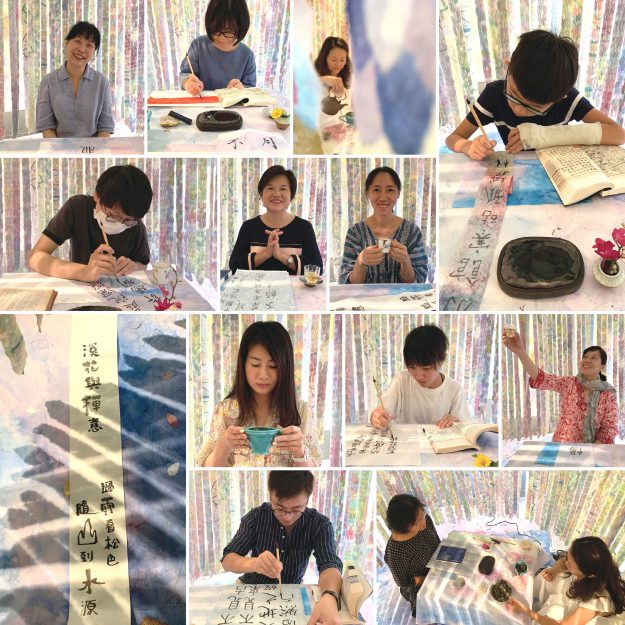
Bodhicitta in the Pandemic
Through mobile teahouses and calligraphy workshops, Sun offers contemplative experiences in-person and online, often for free or by donation. Her public offerings ramped up during the pandemic when she lived near several hospitals in a busy area of Brooklyn, where the sound of ambulances “didn’t stop, and you knew somebody in that ambulance was not going to be able to come home.”
Wanting to be of service, Sun decided to offer more creative opportunities for her local community, with an emphasis on Chinese calligraphy instruction. At first, she concentrated on virtual classes, before masking up to teach while social distancing in city parks. “The practice to arouse bodhicitta worked its way to an extreme during this time,” Sun says. Through a series of grants awarded to her, Sun was able to hold pop-up classes in an unused storefront in Brooklyn, which allowed her to introduce Chinese calligraphy to a diverse set of seniors from the area.
On visits home to Taiwan, Sun often borrowed her father’s books and copied the characters for calligraphy practice, including from the Diamond Sutra by Liu Gongquan. “Gradually, the power of the text [and] the dharma [together] started to work its magic. I copied the sutra three times alone and many times with others.” Sun led workshop participants in sutra writing, including during the pandemic, when they dedicated the Heart Sutra to those who had passed away. She also dedicated community sutra writing to the victims of the war in Ukraine, of local gun violence, and to all of those suffering, sometimes even taking requests for dedications. She still offers a weekly open Zoom “Sutra Collective” every Wednesday night. These public classes allow Sun to be more grateful and generous with her time.
“It’s nice to see people try and take risks,” Sun says. She remembers a specific child’s brushwork from September in the Shenandoah Mountains. “He does a mountain and a river, and I [can] see the old soul coming out from that stroke…it’s very powerful,” Sun tells Tricycle. This type of volunteer work helps Sun to feel more complete in her practice. She notes, “A lot of times, it’s me receiving the gift.”
For Sun, this appreciative, bodhisattva nature also extends to the smaller, more subtle moments of her existence. In the garden, “to cut the flower and put it in front of Buddha…or to have my tea and my bun, this is a perfect match, and it makes me so happy…the little things—that’s life.”
Thank you for subscribing to Tricycle! As a nonprofit, we depend on readers like you to keep Buddhist teachings and practices widely available.
